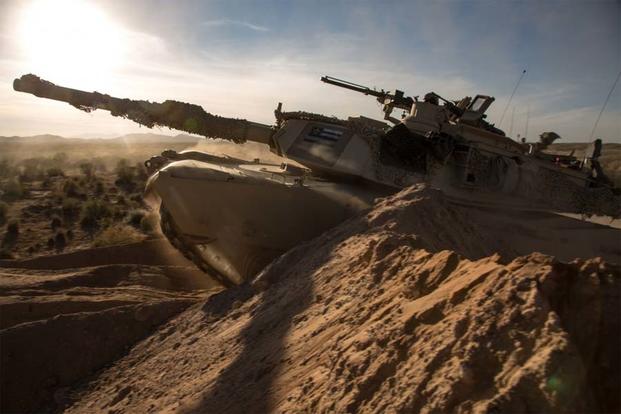The U.S. Army is ranked "weak" and the other branches of services "marginal" when it comes to military power, according a new think tank report.
Overall, American military power is just "marginal" and trending toward "weak," according to the 2017 Index of U.S. Military Power, released Wednesday by the Heritage Foundation, a conservative think tank based in Washington, D.C. The scores are based on the military's "capability or modernity, capacity for operations, and readiness to handle assigned missions successfully," the document states.
The group's Army assessment is the same from last year (the index began in 2015) and stems from the service's decision to decrease the size of the force and delay equipment upgrades to improve readiness -- yet only a third of its units are prepared for war, according to the document.
"Even for units deployed abroad, the Army has had to increase its reliance on contracted support to meet maintenance requirements," the report states. "In summary, the Army is smaller, older, and weaker, a condition that is unlikely to change in the near future."
Military Boost
Based on the U.S. military fulfilling the strategic goal of waging two major wars at the same time, Heritage argues the size of the military must be increased to include 50 brigade combat teams in the Army, 346 surface combatants and 624 strike aircraft in the Navy, 1,200 fighter and ground-attack aircraft in the Air Force and 36 battalions in the Marine Corps.
Similarly, President-elect Donald Trump has called for increasing the size of the Army to about 540,000 active-duty soldiers, the Marine Corps to 36 battalions, the Navy to 350 surface ships and submarines, and the Air Force to at least 1,200 fighter aircraft.
The Obama administration in 2012 argued for changing the force-structure model based on the two-war scenario. The proposal came after Congress and the White House approved decade-long spending caps known as sequestration.
The Pentagon's $583 billion budget proposal for fiscal 2017, which began Oct. 1, requests funding for 460,000 active soldiers, 24 Marine infantry battalions, 287 naval ships and roughly 1,170 fighter aircraft (excluding A-10 ground attack aircraft) -- all for the active component. The figures don't take into account additional troops and equipment for the Guard and Reserve.
The United States spends more on defense than the next several nations combined, with annual outlays of more than $600 billion -- three times more than China and seven times more than Russia, according to figures compiled earlier this year by the Stockholm International Peace Research Institute.
Other Service Rankings
The sea service is sacrificing long-term readiness to meet short-term needs, according to the Heritage report. "While the Navy is maintaining a moderate global presence, it has little ability to surge to meet wartime demands," it states. "Deferred maintenance has kept ships at sea but is also beginning to affect the Navy’s ability to deploy."
Despite an inventory of nearly 1,600 combat aircraft -- including fifth-generation fighters such as the F-22A Raptor and the F-35A Joint Strike Fighter made by Lockheed Martin Corp., the Air Force is facing a shortage of 700 pilots and 4,000 maintainers, affecting its ability to generate combat power, according to the report.
"The lack of ability to fly and maintain [aircraft], especially in a high-tempo/threat combat environment, means that its usable inventory of such aircraft is actually much smaller," it states.
The Marine Corps also faces a partially utilized aviation fleet, with less than a third of its F/A-18 Hornets made by Boeing Co. about a quarter of its CH-53E Super Stallion helicopters made by Lockheed's Sikorsky unit available to fly operational missions, according to the report.
While its modernization programs are relatively on track, the Corps "has only two-thirds of the combat units that it actually needs, especially when accounting for expanded requirements that include cyber units and more crisis-response forces," it states.
Strategic Threats
Even the nation's nuclear forces only received a score of "marginal," according to the document.
While the delivery platforms such as the B-2 Spirit bomber "are good, the force depends on a very limited set of weapons (in number of designs) and models that are quite old, in stark contrast to the aggressive programs of competitor states," it states.
"Russia has rattled its nuclear saber in a number of recent provocative exercises; China has been more aggressive in militarily pressing its claims to the South and East China Seas; North Korea is heavily investing in a submarine-launched ballistic missile capability; and Iran has achieved a nuclear deal with the West that effectively preserves its nuclear capabilities development program for the foreseeable future," the document states.
Defense Secretary Ashton Carter has made the case for a down payment of $108 billion over the next five years in the long-term effort to modernize the nation's nuclear triad that will eventually cost hundreds of billions.
Notably, while Trump has taken a softer approach toward Russia -- he recently talked to Russian President Vladimir Putin on the telephone about possible ways to combat terrorism and the Islamic State of Iraq and Syria, or ISIS -- the Heritage report states "Russia and China continue to be the most worrisome, both because of the investments they are making in the modernization and expansion of their offensive military capabilities and because of the more enduring effect they are having within their respective regions"
-- Brendan McGarry can be reached at brendan.mcgarry@military.com. Follow him on Twitter at @Brendan_McGarry.
Related Video:

























